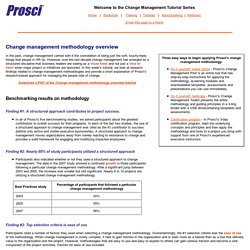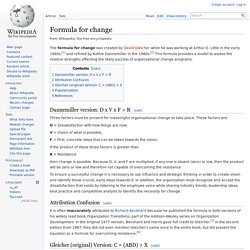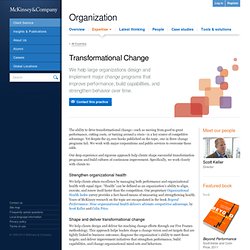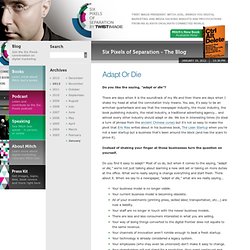

Methodology Overview. Finding #3: Top selection criteria is ease of use Participants cited a number of factors they used when selecting a change management methodology.

Overwhelmingly, the #1 selection criteria was the ease of use of the methodology. When change management is overly complex, it fails to gain traction in the organization and is seen more as a hassle than as a tool that delivers value to the organization and the project. However, methodologies that are easy to use and easy to explain to others can gain serious traction and become a vital component of the project activities.
Factors for ease of use included: Finding #4: When to start change management activities Participants shared data on when they started their change management activities and when they would start their activities on the next project. When did change management activities begin? Prosci's change management methodology Point #1: Change management requires both an individual and an organizational perspective Conclusion: 8 Key Elements Make Your Business Transformative. Formula for Change. The formula for change was created by David Gleicher while he was working at Arthur D.

Little in the early 1960s,[1] and refined by Kathie Dannemiller in the 1980s.[2] This formula provides a model to assess the relative strengths affecting the likely success of organisational change programs. Dannemiller version: D x V x F > R[edit] Three factors must be present for meaningful organizational change to take place. These factors are: D = Dissatisfaction with how things are now; V = Vision of what is possible; F = First, concrete steps that can be taken towards the vision; If the product of these three factors is greater than R = Resistance then change is possible. To ensure a successful change it is necessary to use influence and strategic thinking in order to create vision and identify those crucial, early steps towards it.
Attribution Confusion[edit] Gleicher (original) Version: C = (ABD) > X[edit] The original formula, as created by Gleicher and published by Beckhard,[5] is: References[edit] Kotter International's videos. Transformational Change. The ability to drive transformational change—such as moving from good to great performance, cutting costs, or turning around a crisis—is a key source of competitive advantage.

Yet despite the 25,000 books published on the topic, one in three change programs fail. We work with major corporations and public services to overcome these odds. Our deep experience and rigorous approach help clients shape successful transformation programs and build cultures of continuous improvement. Specifically, we work closely with clients to: Strengthen organizational health We help clients attain excellence by managing both performance and organizational health with equal rigor. Shape and deliver transformational change We help clients design and deliver far-reaching change efforts through our Five Frames methodology. Shift behavior to shape organizational culture Help leaders become models for change Convene leaders and share insights We share our insights at a range of external and McKinsey forums.
Adapt Or Die. Do you like the saying, "adapt or die"?

There are days when it is the soundtrack of my life and then there are days when I shake my head at what the connotation truly means. You see, it's easy to be an armchair quarterback and say that the newspaper industry, the music industry, the book publishing industry, the retail industry, a traditional advertising agency... and almost every other industry should adapt or die. We live in interesting times (to steal a turn of phrase from the ancient Chinese curse) but it's not so easy to make the pivot that Eric Ries writes about in his business book, The Lean Startup when you're not a lean startup but a business that's been around the block (and has the scars to prove it).
Instead of shaking your finger at those businesses turn the question on yourself. Do you find it easy to adapt? Your business model is no longer viable. What would you do? It's easy to say, "go digital. Adaptation, disruption and resting on your laurels. This isn't the end.